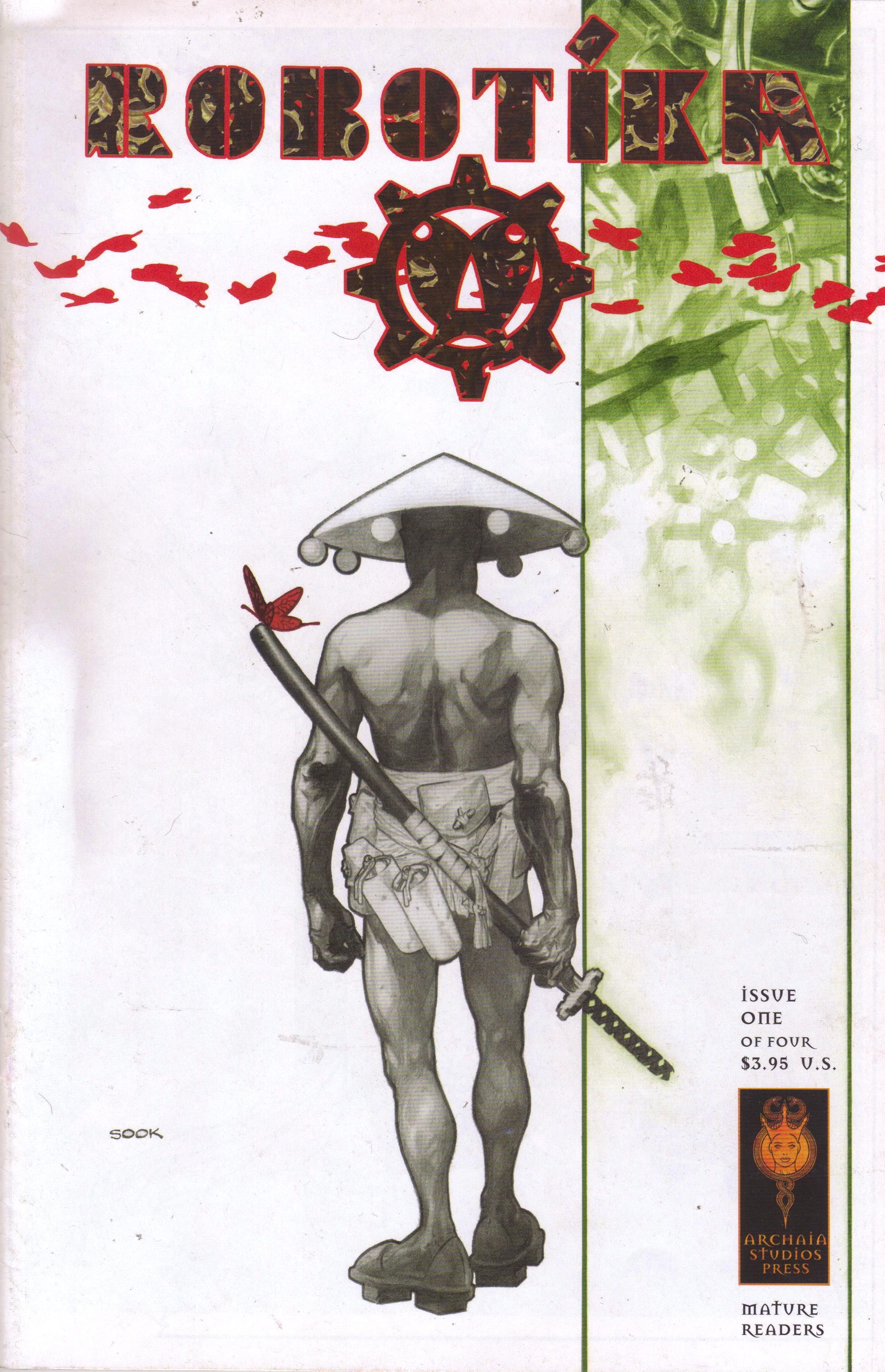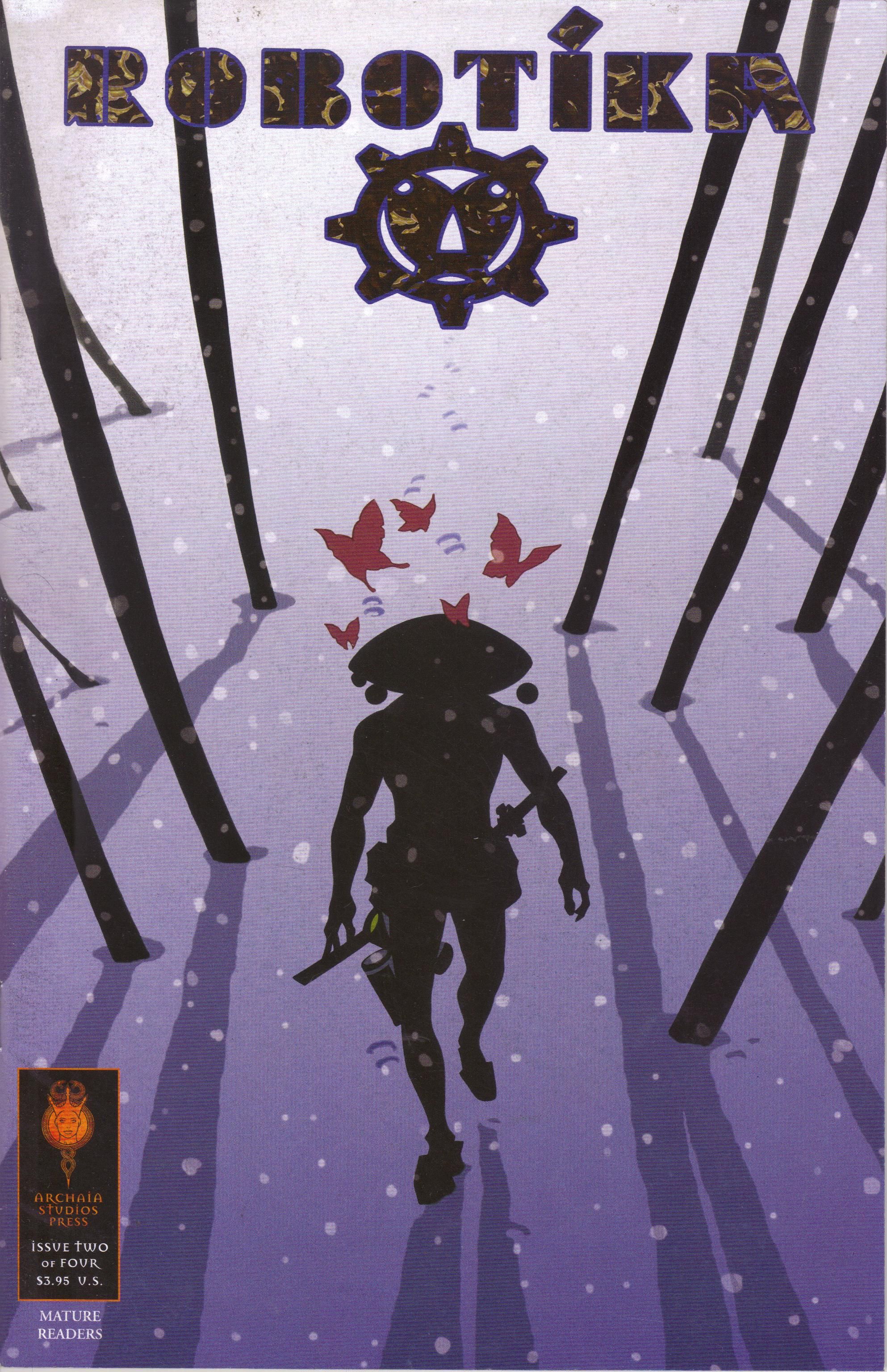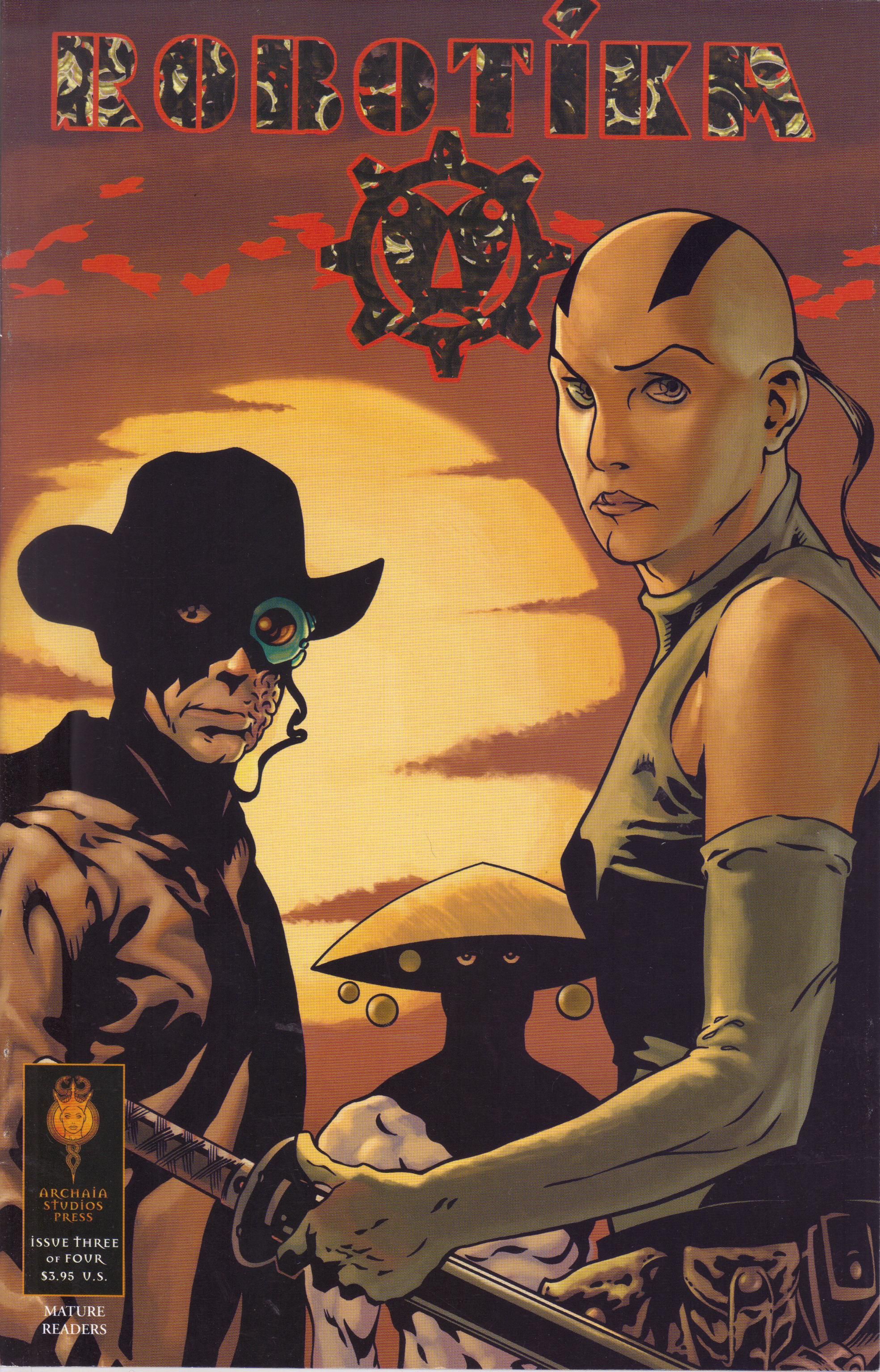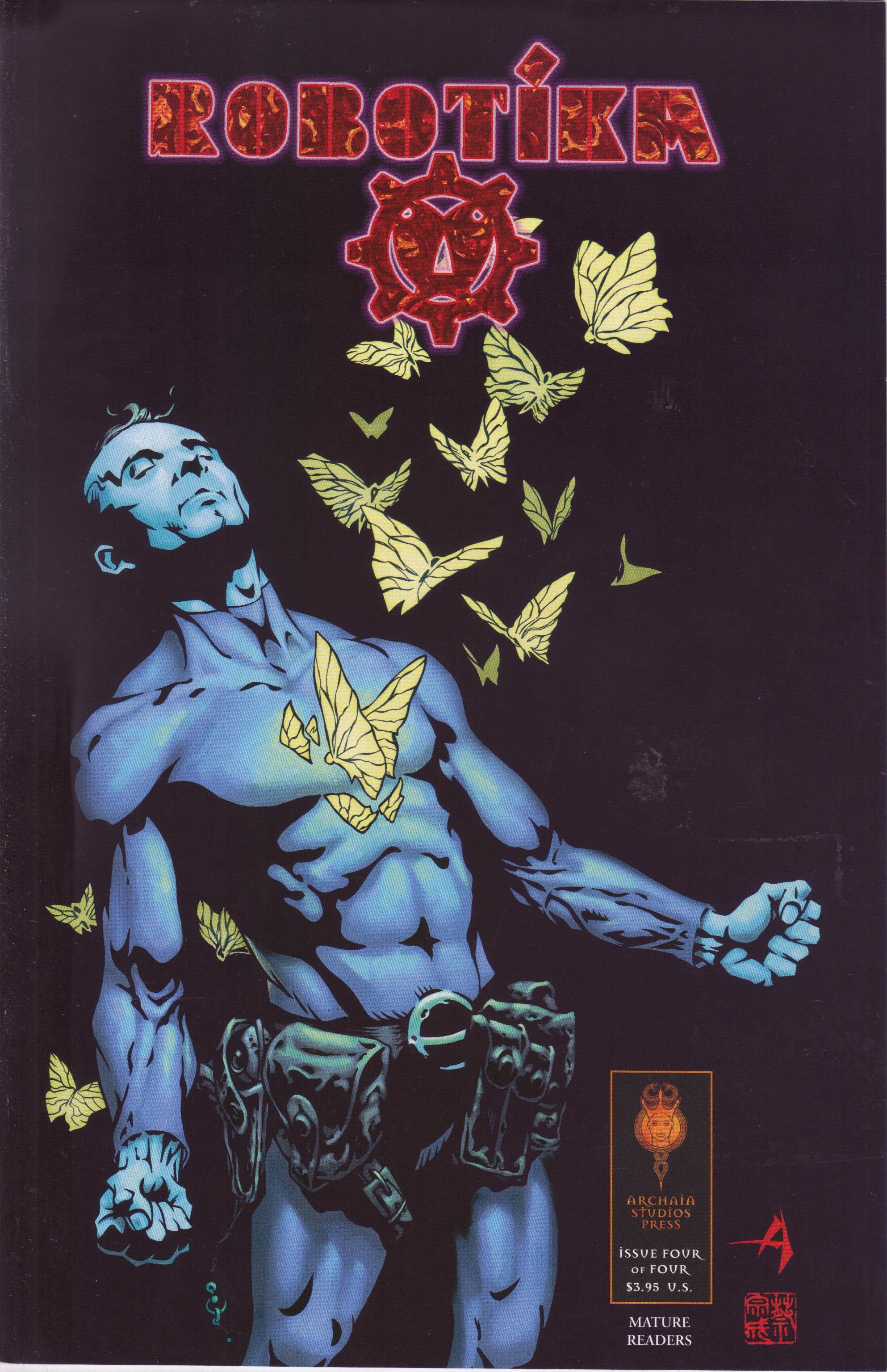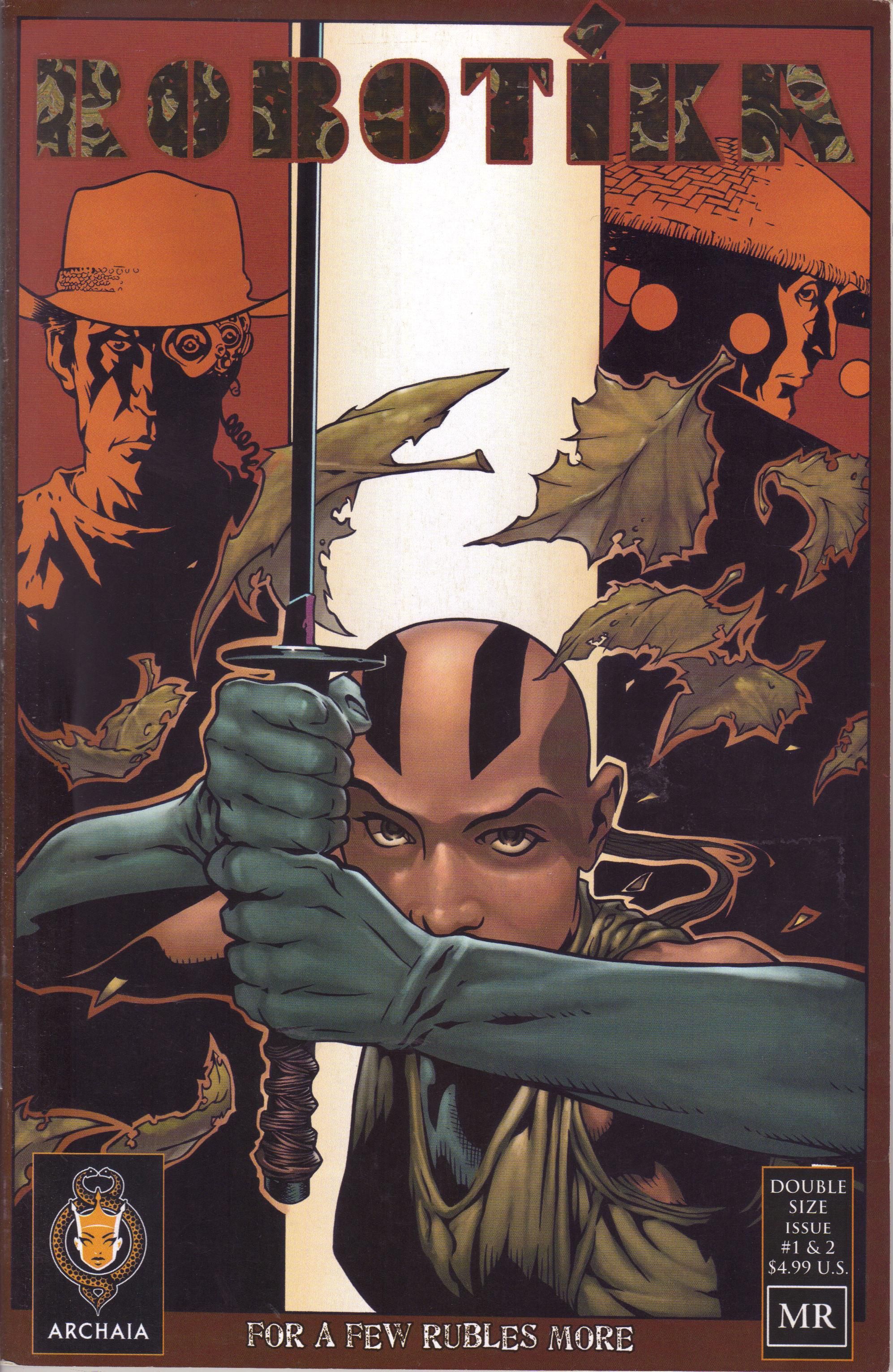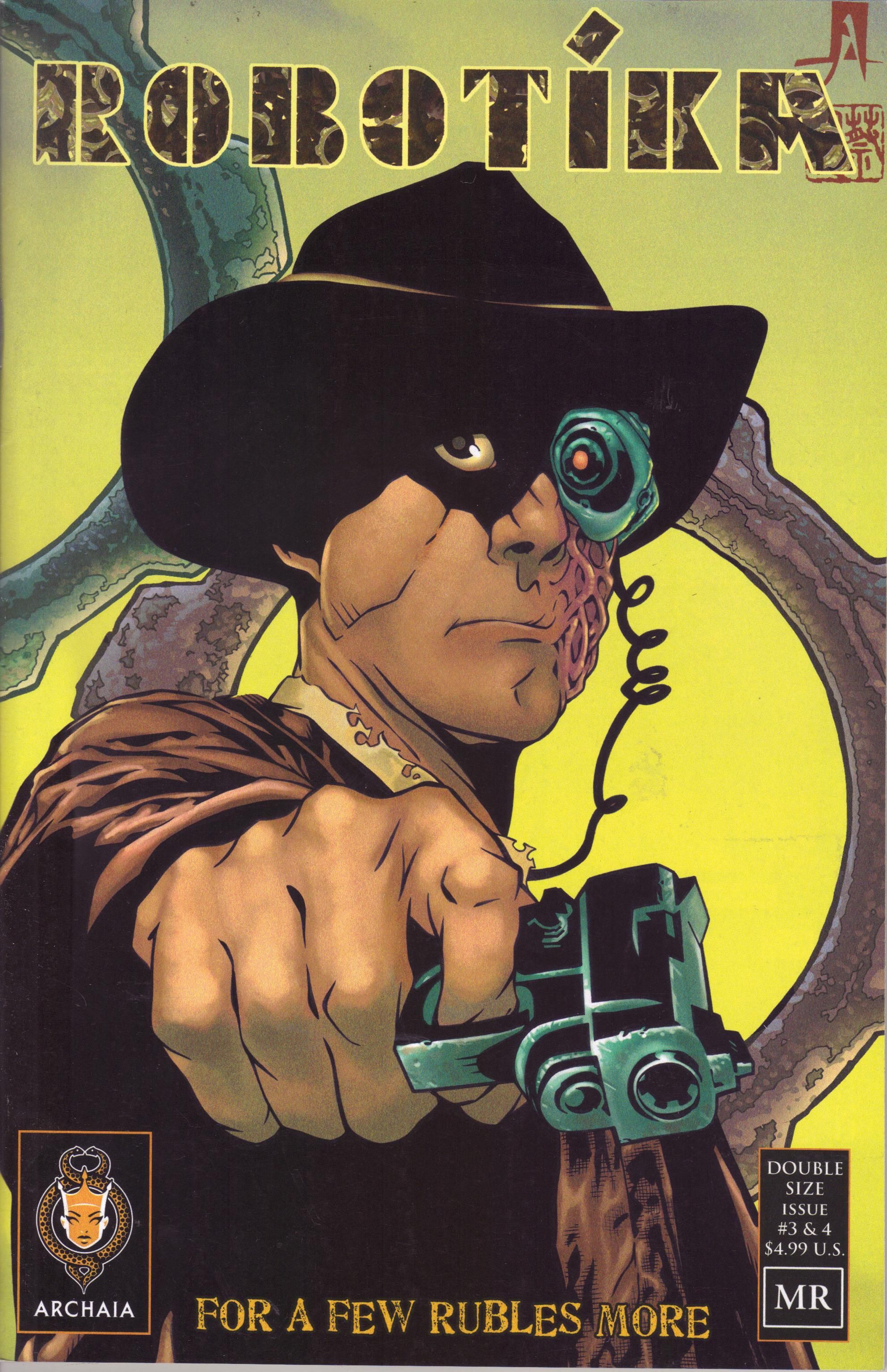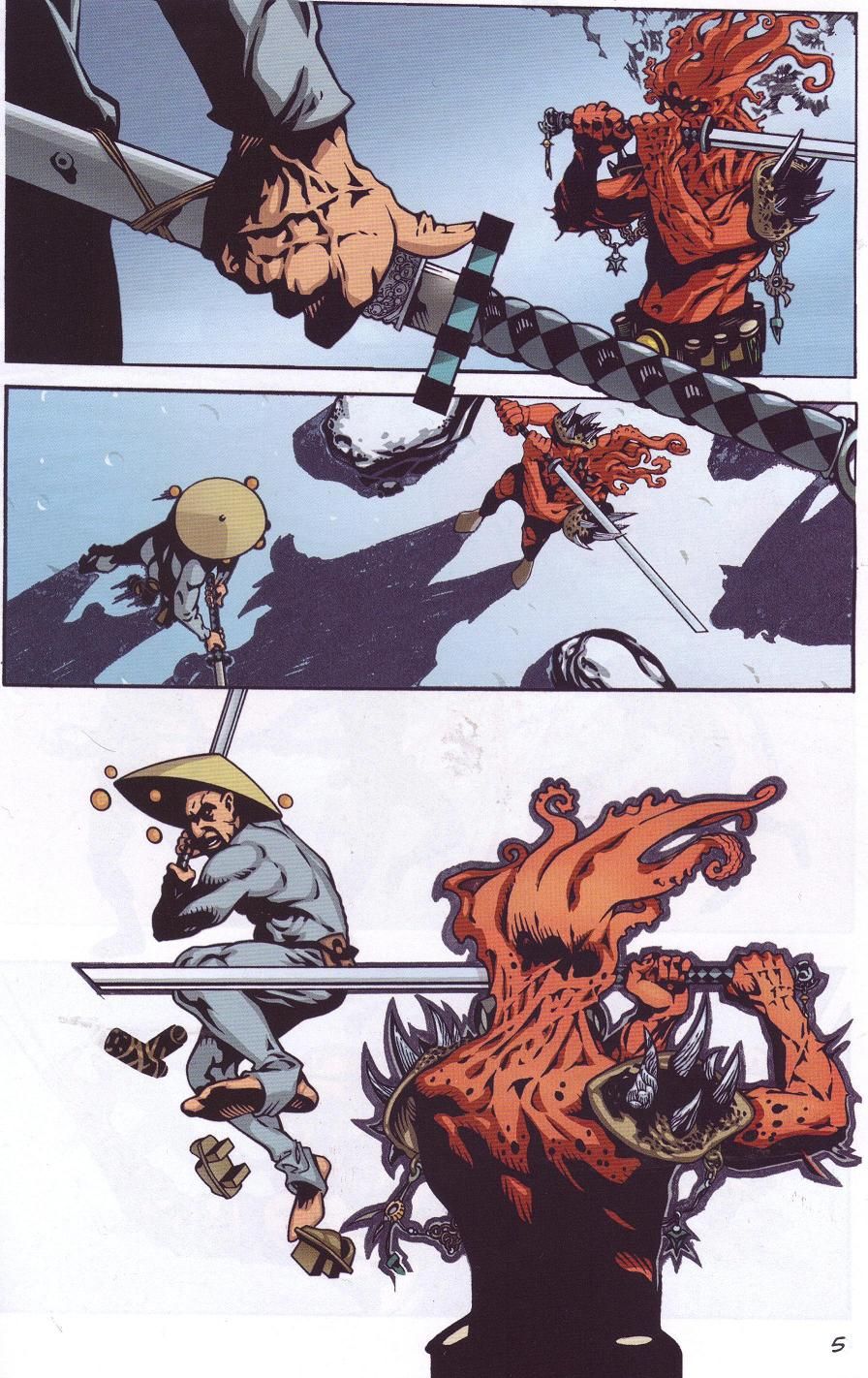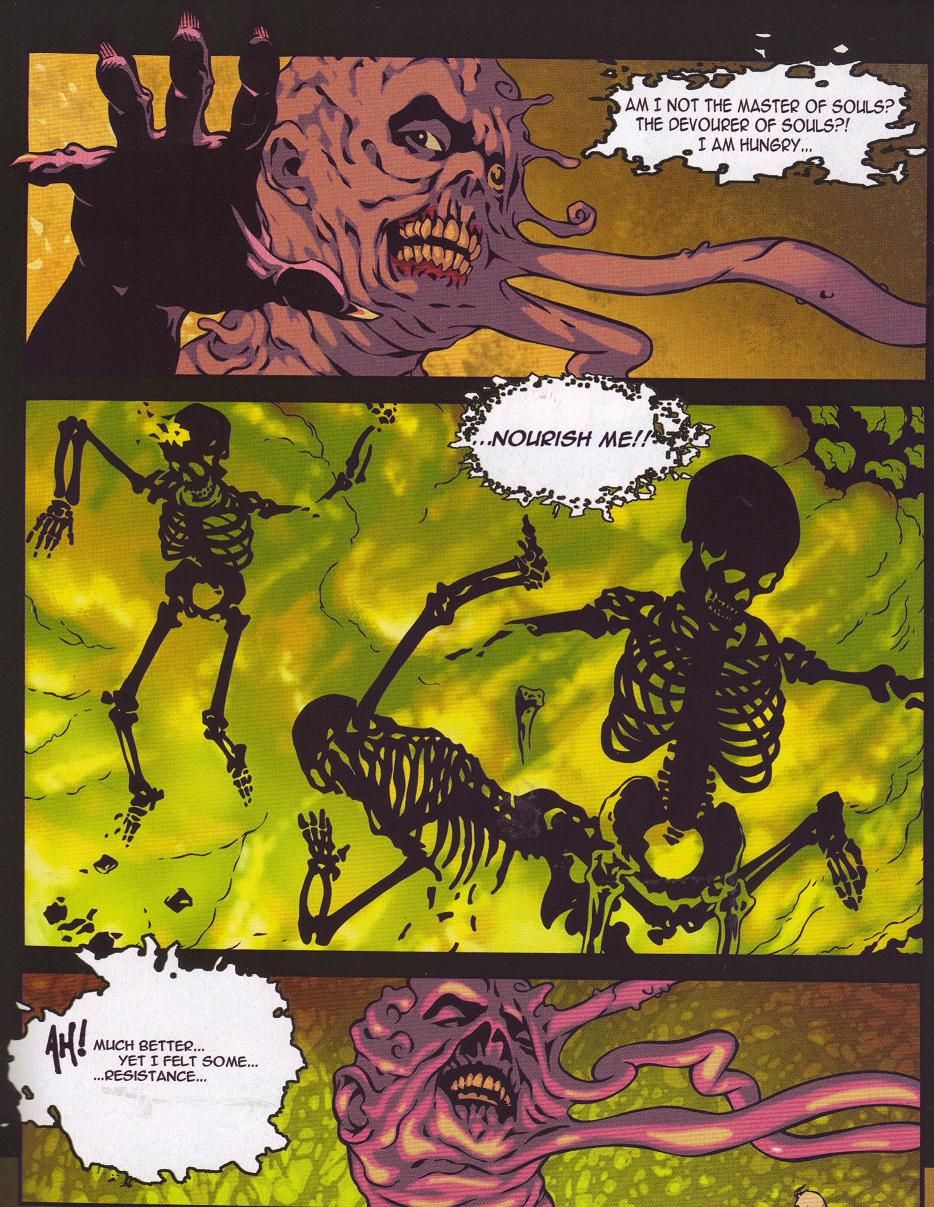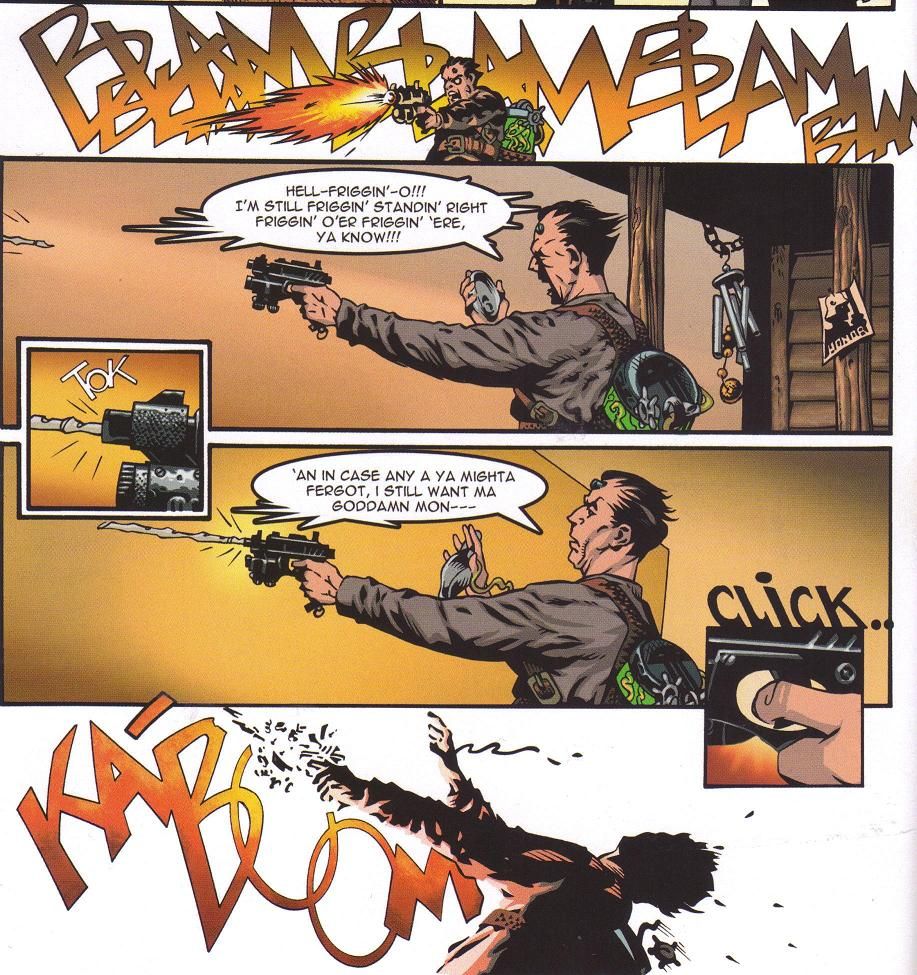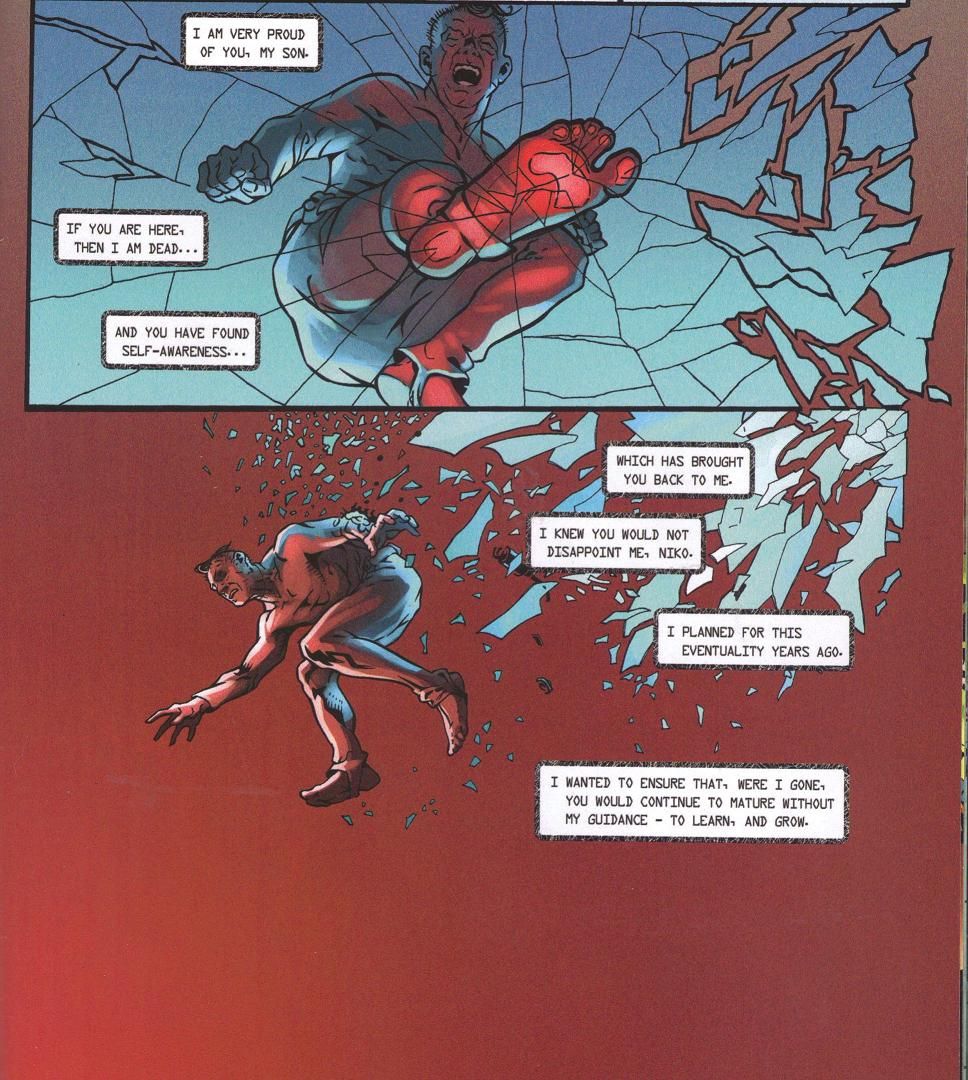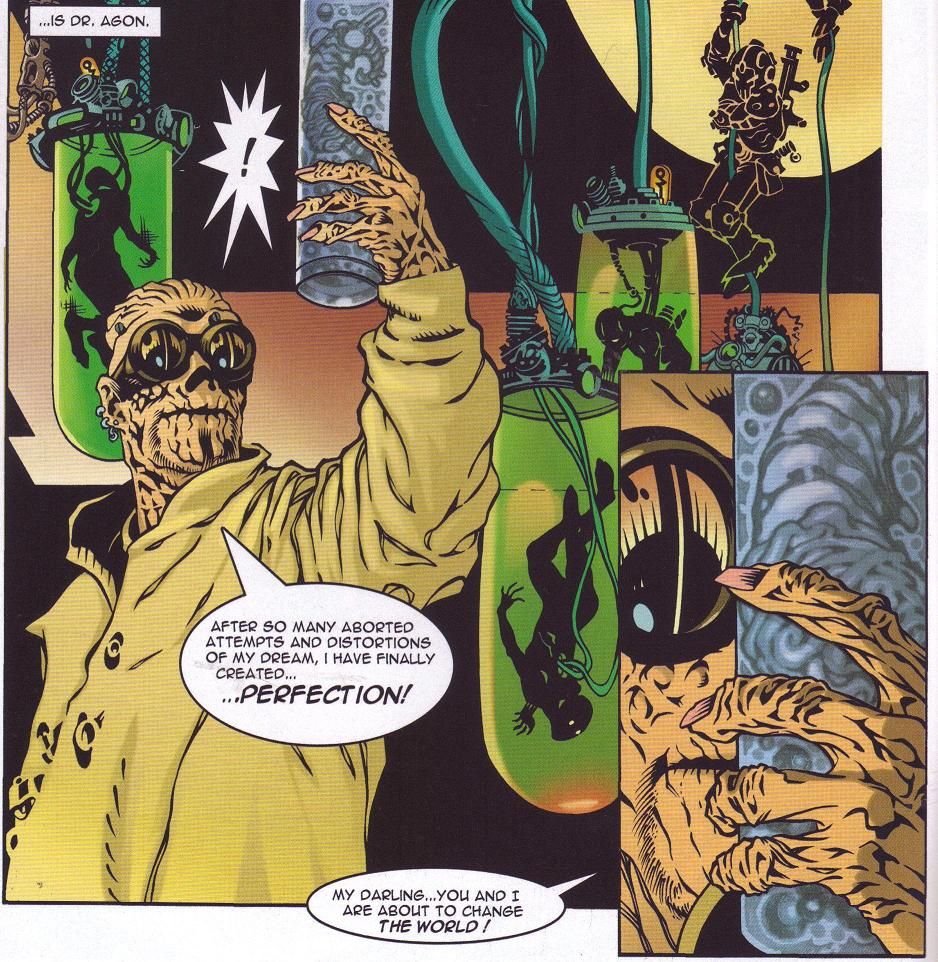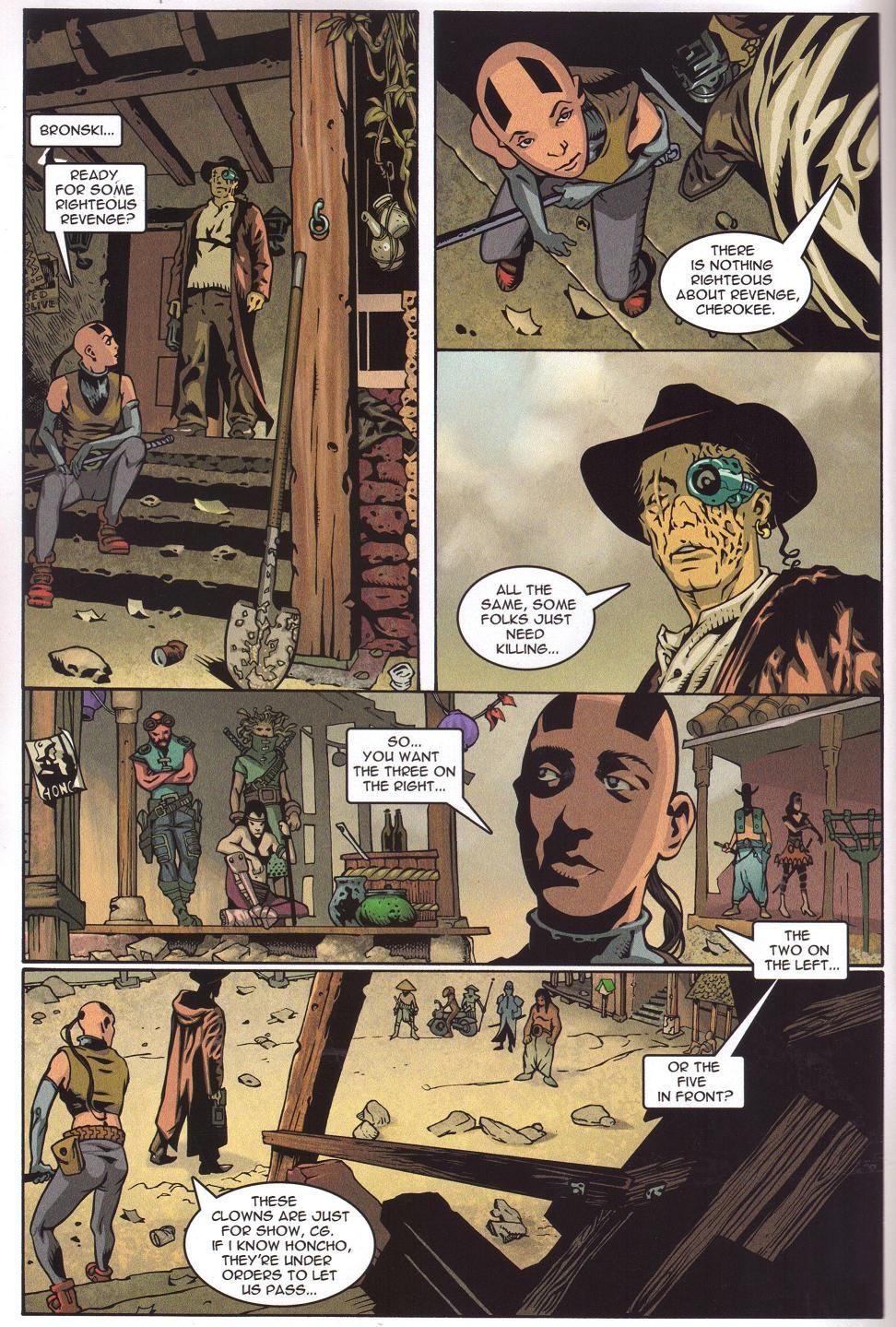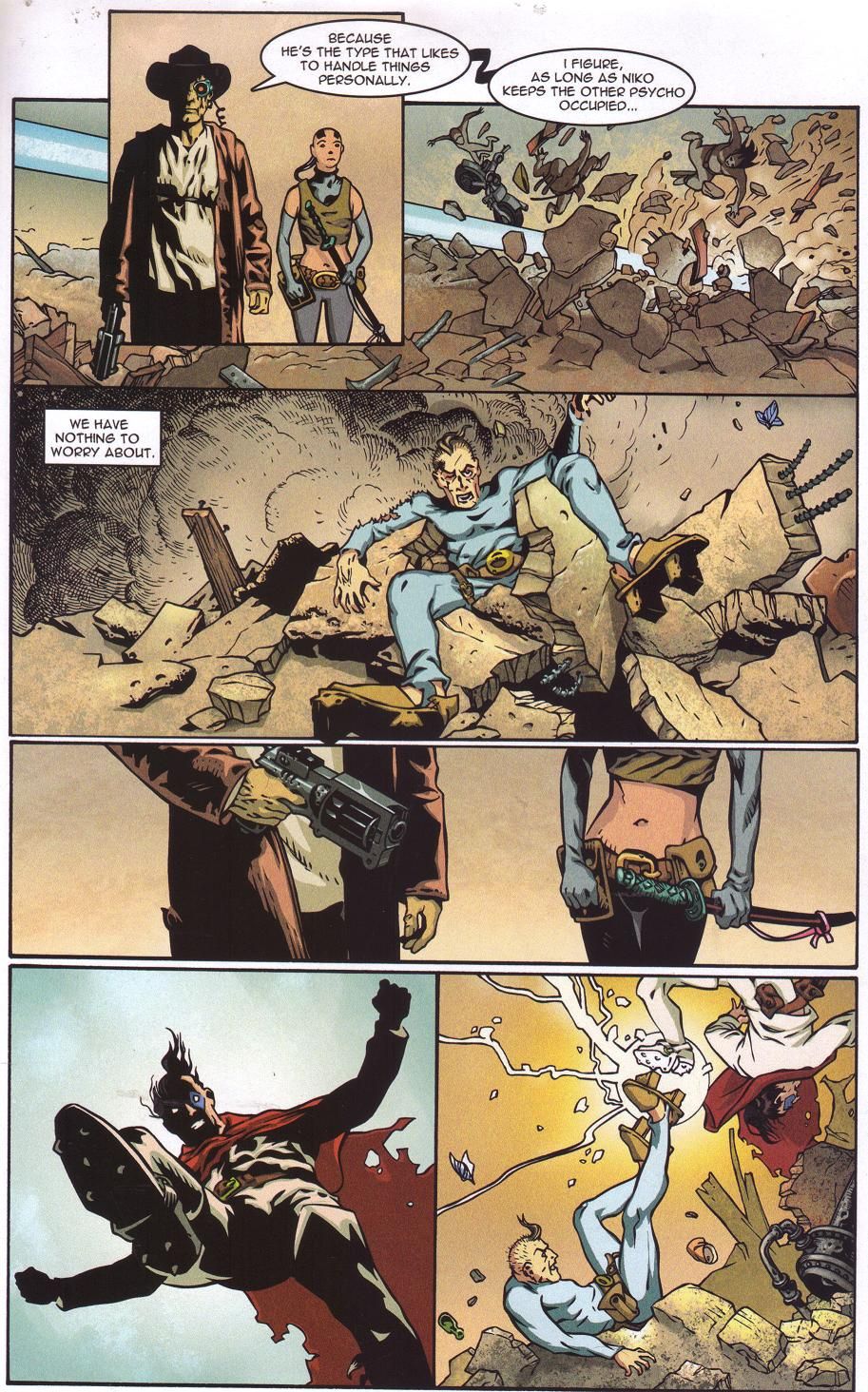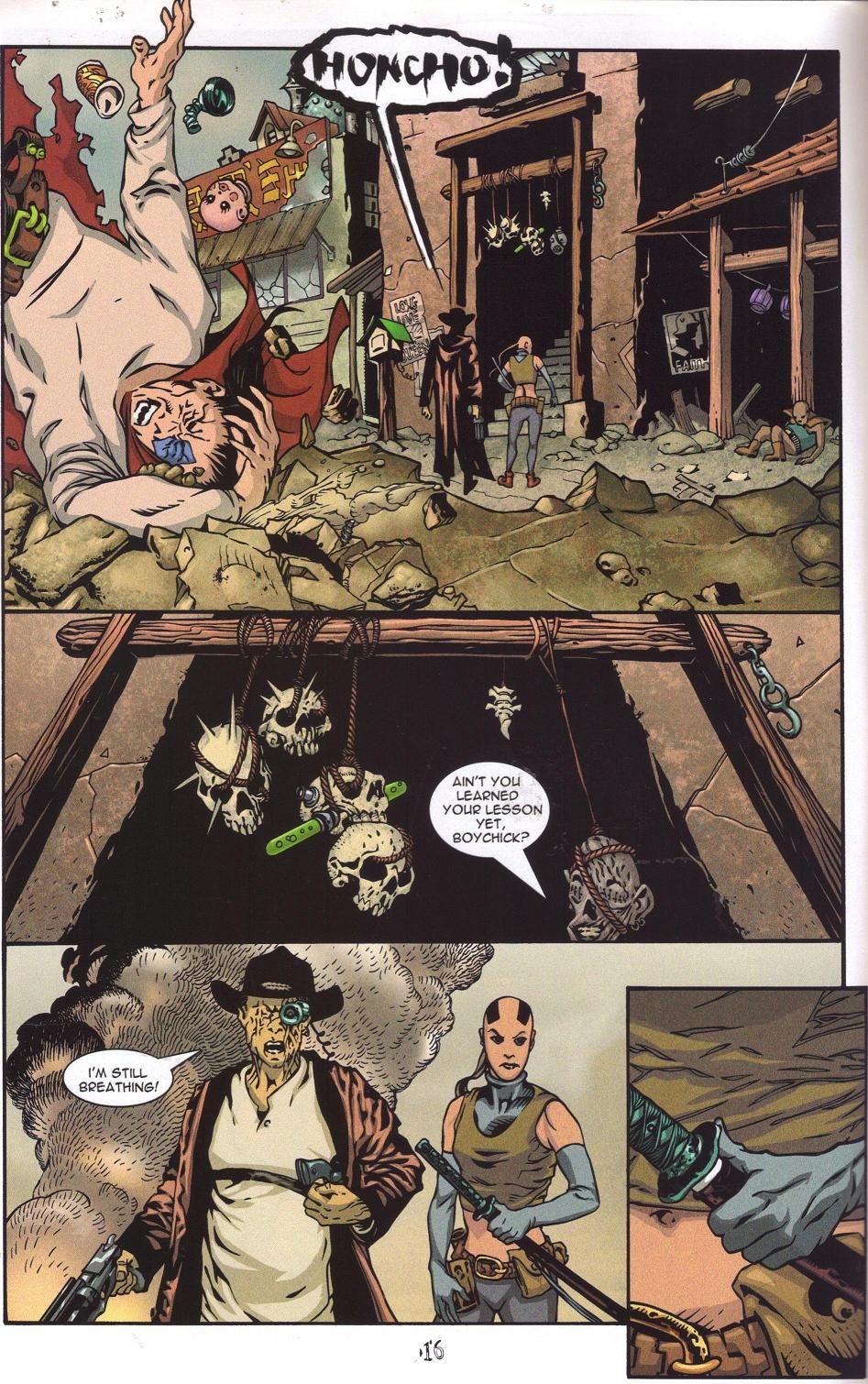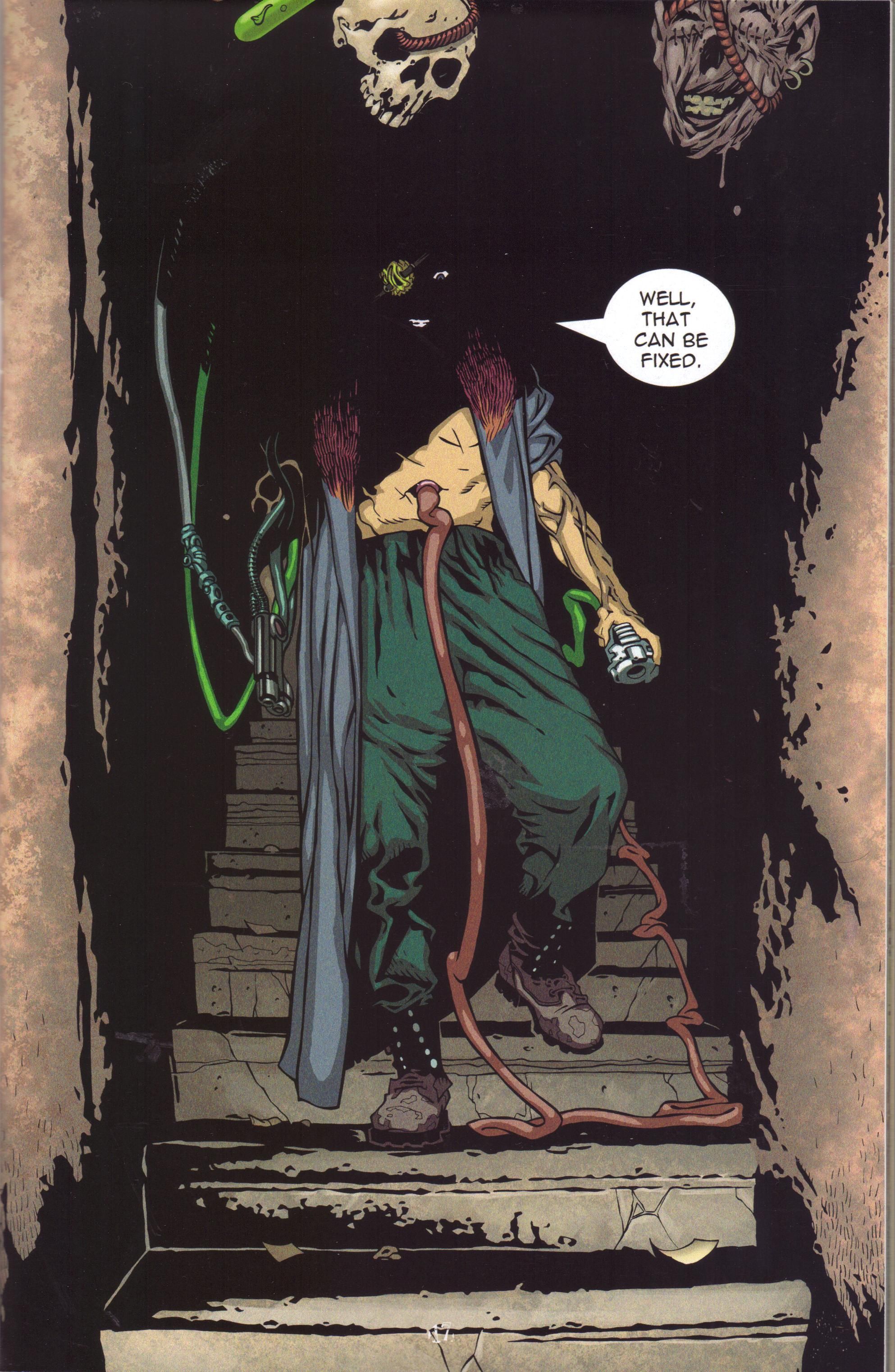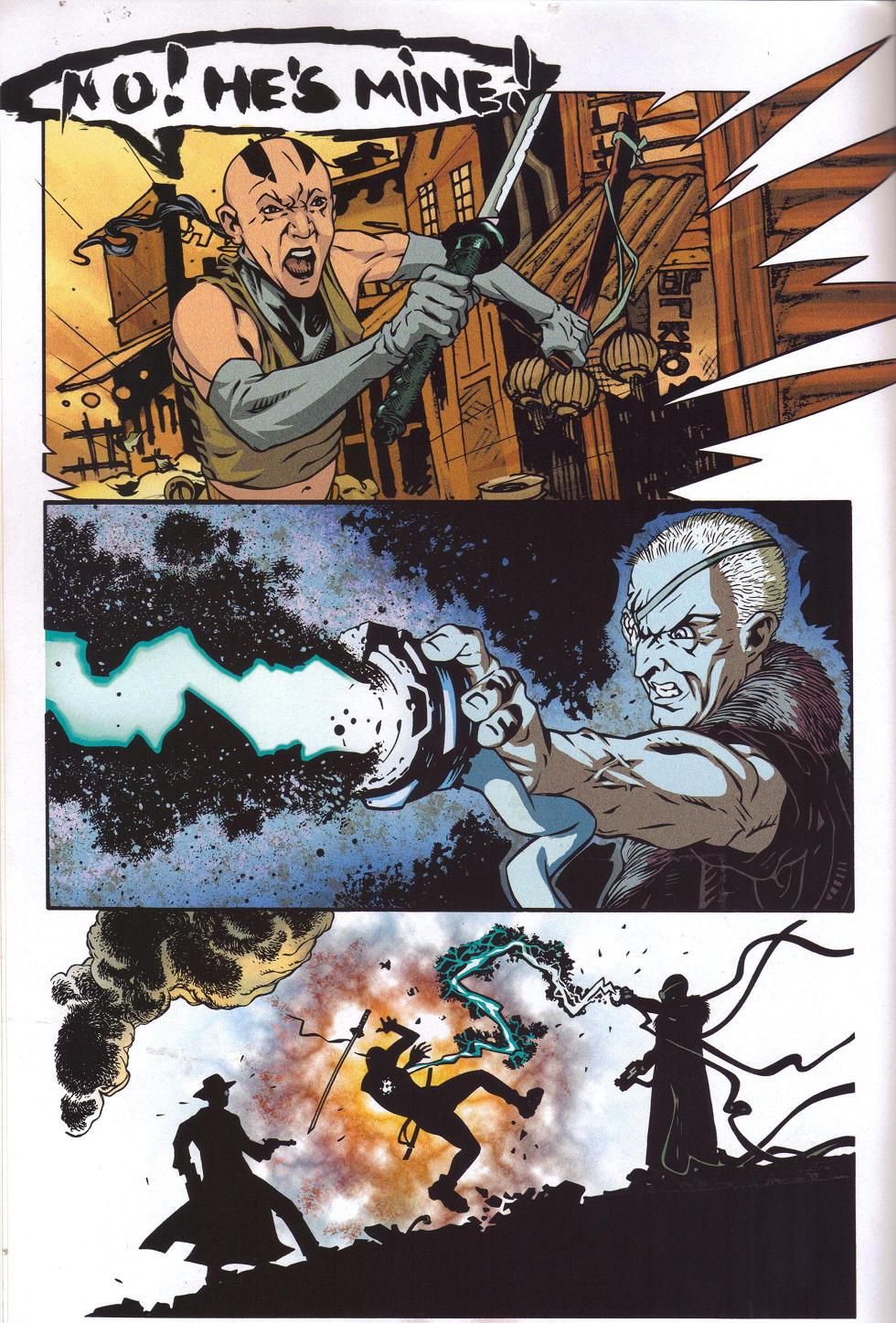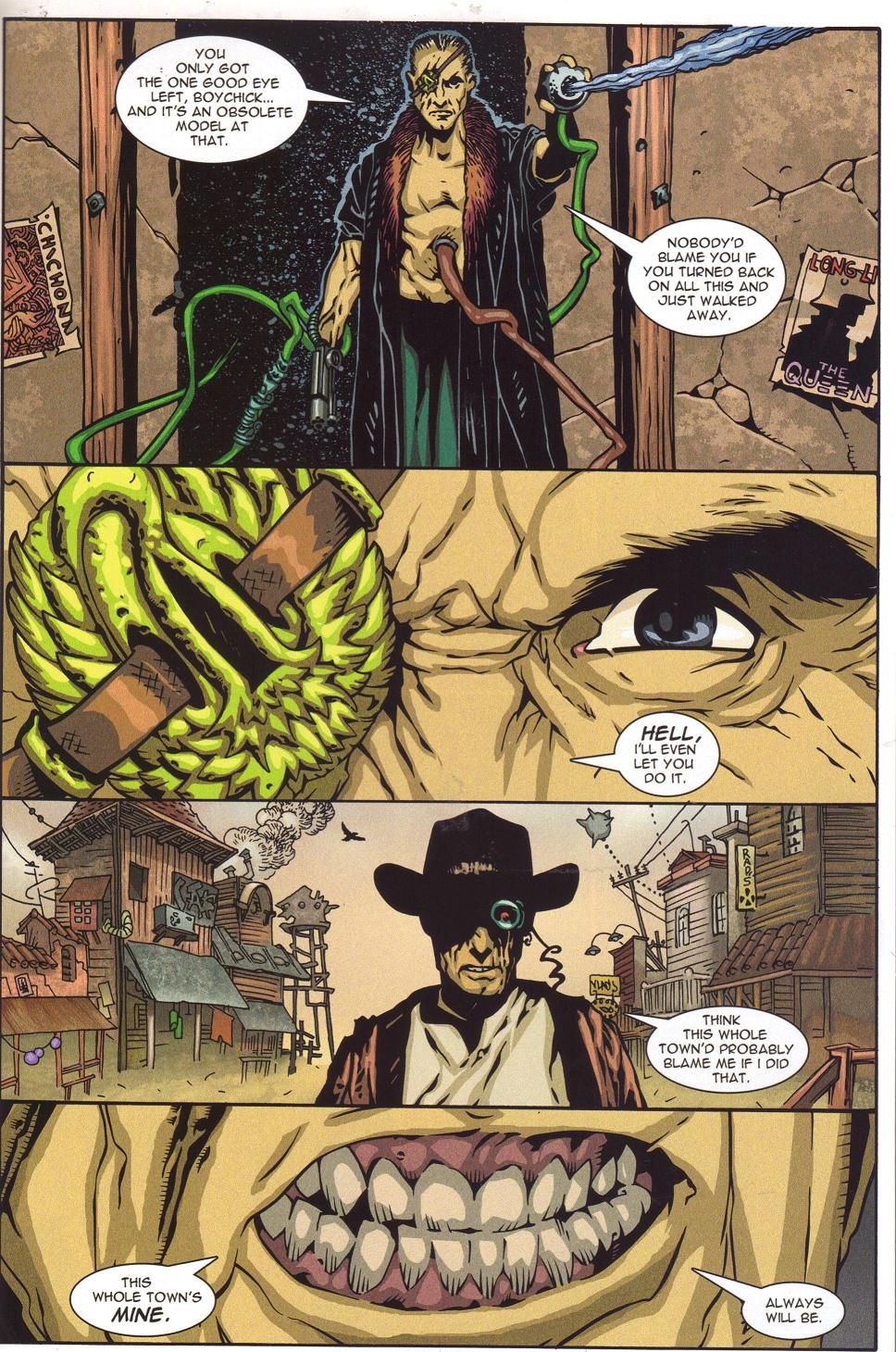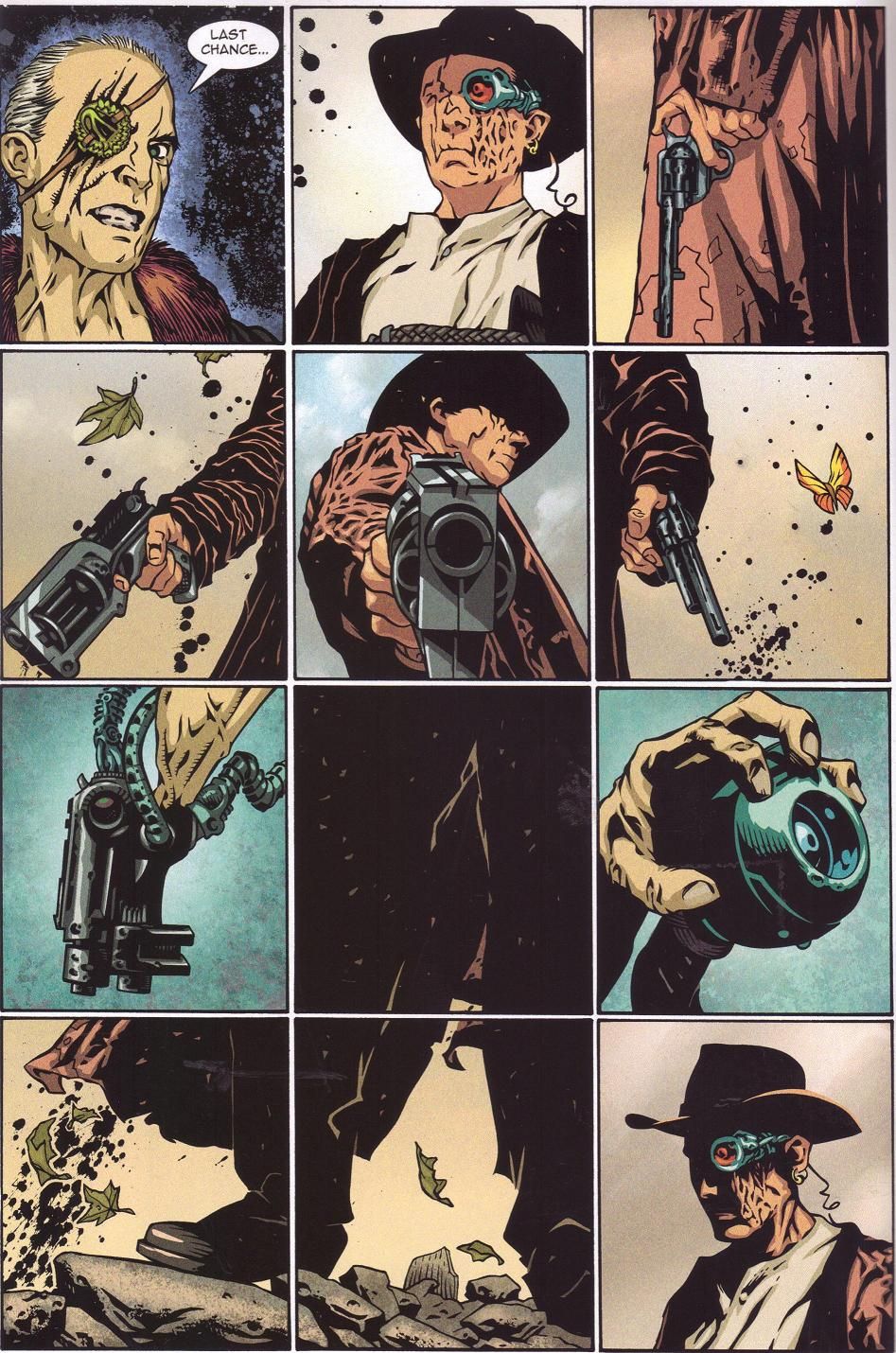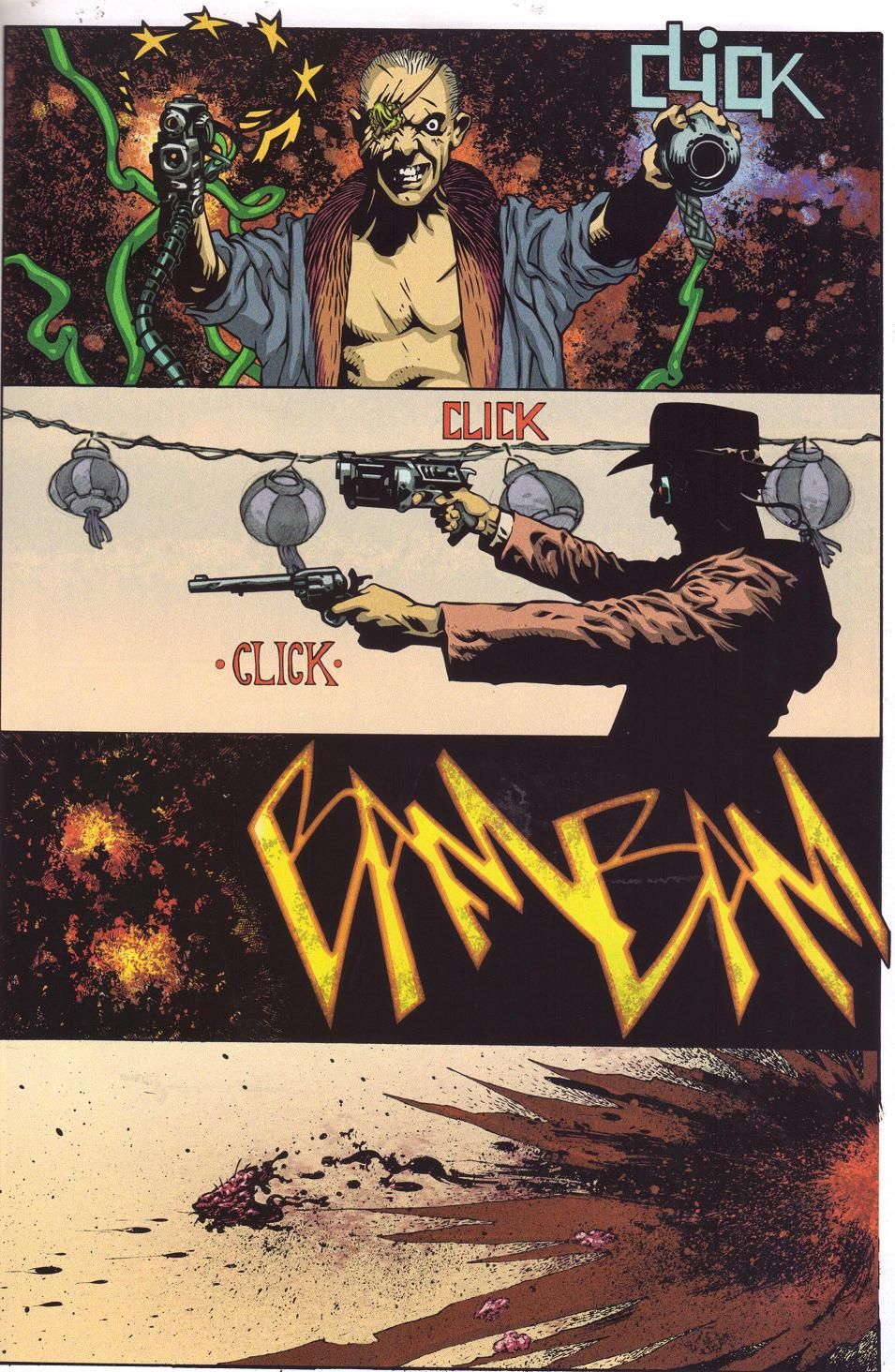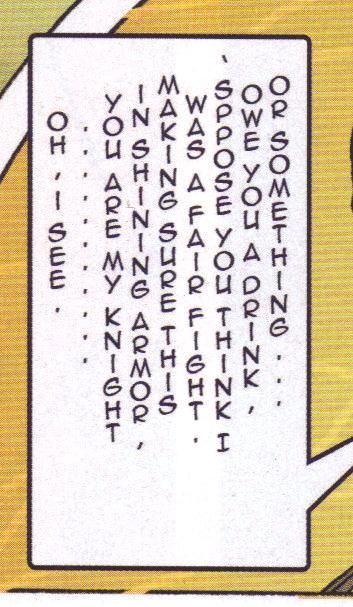This comic book proves there is no justice in the industry!!!!
Robotika by Alex Sheikman (writer/artist/letterer), David Moran (scripter, For A Few Rubles More), Scott Keating (inker, For A Few Rubles More #4), Joel Chua (colorist); "Bronski's Tale" (issue #2 back-up story) by Alex Sheikman (writer/layouter) and Leif Jones (finisher/letterer); "Cherokee Song" (issue #4 back-up story) by Alex Sheikman (writer/inker), Travis Sengaus (penciler), and Joel Chua (colorist); "Dr. Agon or How I Learned to Stop Worrying & Love Cyber-Robotic Enhancement" (For A Few Rubles More #4 back-up story) by David Moran (writer), Norman Felchle (artist), and Joel Chua (colorist).
Published by Archaia, 8 issues (Robotika #1-4 and Robotika: For A Few Rubles More #1-4, although the second series stopped after issue #1 and was eventually published as two "combined" issues of #1-2 and #3-4), cover dated December 2005 - June 2006 (first series), December 2007 (issue #1 of For a Few Rubles More), and June and October 2009 (the combined issues).
Alex Sheikman is a name that should be more well known in comics circles. With the first issue of this series, he showed that he was an amazing artistic talent who deserves a much higher profile than he currently has.
That DC or Marvel has never begged him to draw something for them is ridiculous. I don't know how slow he is, but he could easily draw a mini-series or graphic novel, a project on which he could take his time a bit. As much as I like Emma Ríos, for instance, the fact that Sheikman didn't draw the new Doctor Strange graphic novel that just came out from Marvel is silly. He would kill on a Doctor Strange comic. (Honestly, so did Ríos, in a completely different way. I just think Sheikman doing Doctor Strange is a no-brainer.)
Robotika is his masterpiece, so far, although he's technically not done with it (and I have no idea if he plans to return to this world). The story is fine, although the plots are somewhat generic. Sheikman takes Seven Samurai and makes it into a Western (that's a great idea; someone really ought to do that right away), then mashes it up with Blade Runner and The Matrix. He wears his influences proudly on his sleeve, but there's nothing wrong with mixing genres and influences as long as it's done well. While the story is decent, the plot is certainly not why this is a Comic You Should Own. The story takes place in the "far future," and on the first few pages, Sheikman explains what has happened in the world. Geneticists created enhanced humans, while other scientists created cool cyborgs, but the "unified ideal of a true cyber-genetic hybrid" remained elusive. As new generations of cyborgs were created, the earlier ones were left behind and became a sub-class in society.
The first plot concerns a scientist actually creating a biological machine that can reproduce, develop, and learn. The queen believes this will start a war between humans and cyborgs, because why would the cyborgs need humans if they themselves can become dominant? Sheikman uses this plot to introduce two of his three main characters - Niko, a silent samurai, and Cherokee Geisha, a slightly enhanced human (she has a cybernetic voice box, at least). In issue #2's back-up story, he introduces the third "yojimbo," a man named Bronski, who officially joins the cast in issue #3. The first mini-series features two different stories, each with a MacGuffin at the center of the plot - the scientist's invention drives the plot, certainly, but it all leads to a rather wry and ironic ending as well as Niko giving up his sword (but not necessarily violence), while in the second story, a group of pilgrims voyage to visit their god, which is incidental to what we learn about Niko and his soul. Sheikman also uses this story to set up the third, as-yet-non-existent mini-series (the second mini-series is a bit of a pit stop before the yojimbos can reach their destination). The way Sheikman undercuts the importance of the plot in the first mini-series is actually one of its charms - we think the first story is about Niko searching for something that will change the world, but Sheikman (either by predetermined design or because he changed his mind along the way) simply veers around any philosophical considerations of a cyber-genetic hybrid and moves the series in a completely different direction. I imagine he planned it from the start - Niko's break with the queen and his renunciation of violence comes about because of the queen's capricious actions at the end of issue #2. The book still deals with the idea of a perfect cybernetic organism, but that's because, as we learn in issue #4, Niko himself is that organism, or at least as close as anyone has gotten.
Unfortunately, he lacks a soul, and Sheikman deftly makes the book about the yojimbos' search for their own souls - yes, Niko was partially created in a lab (he was gestated in a womb, it appears, but not inside a woman), and his quest is the most obvious, but both Cherokee Geisha and Bronski are also, in their own ways, searching for peace. So the plots don't matter as much as the themes that Sheikman is exploring.
So the main theme is the search for belonging, either through acquiring a soul (in Niko's case) or through other means. Niko spends a good deal of the second mini-series on the sideline while Cherokee Geisha and Bronski get the spotlight. For the first three issues of For A Few Rubles More, Niko faces down a man called St. Just, who's the main enforcer of the big villain, Honcho, and is a man whom Niko seems to know. Neither man speaks, which makes their confrontation all the more tense - for many pages they simply stand staring at each other while the action unfolds around them. Finally they fight, but their fight takes on mythic proportions, seemingly lasting over the course of an entire night, again while more important things happen around them. Finally, in the final issue, Niko fights in a virtual tournament and gains the sword, only to have Sheikman throw another twist at us. Niko continues his search, because he realizes that he has a greater quest than finding his soul. Meanwhile, the rest of For A Few Rubles More concerns both Cherokee Geisha and Bronski. In issue #4 of the first mini-series, we learn that Cherokee Geisha was a tomboy and her brother wasn't as skilled as she was in fighting. Her father rejected her because he wanted his son to carry on his legacy as a warrior, so she left home. Eventually her brother hung himself from shame. In For A Few Rubles More, Cherokee's father re-appears and begs for her forgiveness.
Sheikman doesn't make too big a deal about it, but Cherokee is obviously searching for a father figure - both Niko and Bronski "feel" older than she is, and she craves their approval even as she hides behind a façade of cool. Her father had already repented his foolishness, but when he re-enters Cherokee's life, he's able to find out that his daughter has become a great warrior and a noble spirit. It gives both of them a measure of peace. Bronski, meanwhile, is thrust into the spotlight because Honcho is the man who burned out his eye, so For A Few Rubles More becomes a bit of a revenge story, but it's also about Bronski, like Cherokee, confronting his past and moving on. He has never been able to let go, so when he enters the town (it appears to be called "Vetograd," but some of might have been cut off by the panel border next to which the sign appears), he can not only deal with his past, but also look to the future. He falls in love and realizes that he's never had a home, so he stays behind while Cherokee and Niko head off to Novo Edo (the capital) to find the sword. Sheikman might not be the best scripter (he obviously thinks he needs help with it, as he brought on Moran in the second mini-series), but he's a pretty good plotter, and the theme of the series sneaks up on us a bit, which is nice.
As interesting as the story is, the real greatness of Robotika comes from the art. Sheikman has a lush, intricate style that brings this strange future to vivid life. We see this on the first page, which shows several tanks full of various lab-grown "cyber-genetic hybrids." Sheikman combines a twisted vision of horrific combined life forms with steampunk machinery, a sensibility that informs the entire comic.
He creates this world from the ground up, from the myriad number of life forms to the oppressive Novo Edo, which is more of a hive than a city. The towers of the city form odd mushroom shapes, peppered with lighted windows, almost breathing, which adds a level of eeriness to the civilization of this future. Early on in the series - the first two issues primarily - Sheikman uses blacks heavily, making the first foes Niko fights on his quest almost negative images, existing outside this reality. Sheikman eases up on this technique as the series moves on, but his use of shadows is a huge part of the effect of the book. He also creates "chapter breaks" that look like parchment with Japanese drawings etched upon them - the book is set in a quasi-Japan of the future, after all, so it's not too crazy, but the way Sheikman "ages" the paper - digitally, I would imagine - and creates delicate drawings of Niko posing helps add to the Asian flavor of the comic. Sheikman alters the art to fit the mood of the book rather often - when Niko is fighting in the virtual world, Sheikman shades the artwork differently and uses slightly fewer details. In several places, he draws the outline of a figure or figures but then fills the space with a different drawing, in this way telling the story visually in conjunction with the story being told verbally. In For A Few Rubles More, Sheikman lays the pages out in a bit more conventional manner, but his pencil work is as superb as ever, and in the final chapter, he layers the page in three rows, each telling a different aspect of the story at different times. It's the kind of thing that can only be done in comics, and Sheikman does it very well.
It's the details of the book that stand out, though - Sheikman is very detailed, but not in a cross-hatchingly crazy kind of way. He's very precise, giving us a rich world of odd, pseudo-organic entities, such as the "virtual reality helmets" that look like brains or the twisted flesh of the "mecha-betsushikime." The art on Robotika is creepily sensual, as machine melds with flesh to create odd combinations, as we see with the octopus-like "master of souls" in issue #4 of the first series.
When the series shifts to Vetograd in For A Few Rubles More, Sheikman creates a gorgeous western steampunk town, full of clanky machines and wooden buildings, then populates it with his cybernetic organisms armed with samurai swords and high-tech guns, adding to the dichotomy of the story. It's difficult to describe how intricate and beautiful the art is, because Sheikman uses so many interesting techniques. He surrounds his characters with ornamental starbursts that serve no function except to highlight the class differences between the people, and he uses cartoonish stars or large exclamation points to deflate the seriousness of the story (the book has a sense of humor, even if the stories are generally serious). In a couple of places, he turns the page into puzzle pieces, as Niko learns more about his past. Meanwhile, Joel Chua's colors are stunning. He gives Niko a pale blue shirt, making him a cooler character than the gritty Bronski (who wears a brown duster) and Cherokee Geisha (who wears khaki). Early on (when Niko's outfit is more gray than blue), the contrast between Niko and the queen, who's wearing a bright red dress, is obvious, but even later, Niko still stands out in this world of browns and dark reds. In the first series, Chua uses fluorescent green for the supernatural elements of the book, adding some unreality to the book, and this carries over to For A Few Rubles More, in which there are fewer supernatural elements but where Chua still uses green with Honcho, who's the bad guy in the story. The fact that he colors the virtual world blue links it to Niko, who's very comfortable in that milieu. As superb as Sheikman's pencils are, Chua's colors help make the book a stunning work of art.
(I've shown this sequence before, but I wanted to show it again, because it's so tremendous. Click on the scans to enlarge them - you can do it for any of the scans in this post, of course, but these are really keen).
If you're a fan of gorgeous art, Robotika should be on your must-own list. As a narrative, it's slightly less successful (only slightly), but Sheikman does manage to balance between pure pulp action - I mean, there are gun fights, sword fights, and hand-to-hand fights, so it's not like it's boring - with interesting meditations on who we are and what makes us thus. The plots are solid, but once you're done reading this, you understand that Sheikman is far more interested in the thematic elements of the comic rather than "what happens." Robotika is far more subtle than it appears at first glance, and it makes re-reading it a delight, especially as Sheikman and Chua's artwork continues to astound and reveal new things. It's also interesting in how experimental it is - Sheikman toys with a lot of different things in the artwork, and I even purposefully ignored the way Cherokee Geisha speaks in the first series until now. Here's how Sheikman designed it:
Sheikman did it this way because, as he writes in issue #2 (it's all [sic], by the way, because there are some mistakes):
English is my second language and I still remember the frustrating experience of not being able to communicate with people around me. I also remember how rewarding it was when finally I started "getting it", a whole new world opened up for me. ... With Cherokee Geisha I wanted to create a character that either could, or could not, be understand by other characters (but somehow the reader would always be able to understand). I wanted the reader to realize that they are taking a very wonderful thing, English language and ability to communicate, for granted. "Yes", I did want the reader to work hard. "Yes", I did want the reader to have to "re-learn" how to read ... because I wanted them to feel achievement at the end of that experience and an appreciation for something that they usually take for granted.
He changed her speech pattern in For A Few Rubles More (in a hilarious fashion), but I found the experiment interesting, because it's really not that hard to read, but it does slow you down and make you figure it out, so I think Sheikman accomplished what he set out to do. A lot of Robotika is like that - Sheikman is trying different things, and they almost always work.
Sheikman is working on a lot of stuff these days, and I don't know if he has any plans to return to Robotika. Both series are available in beautiful hardcovers which would look really nice on your shelves. I don't think you'll be disappointed if you check them out.
It's been a while since I finished one of these posts (sorry!), but there are still plenty of comics to read about in the archives. I do hope I'll be quicker with the next installment. I do love writing these things, but I've been really busy this year with the daily posts. What the heck was I thinking?!?!?!?


